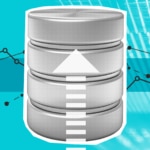The “AIOps” in database observability.
Let’s begin with some of the most basic examples of how AIOps can immediately impact monitoring mission-critical databases. Imagine a severe service outage to your e-commerce site, causing millions of dollars in revenue lost every minute. You’re able to trace the root cause to changes in the query response time, but this results in your monitoring software generating an overwhelming number of alerts (an alert storm) from multiple levels throughout the application and infrastructure. AIOps helps reduce alert noise by identifying anomalies in different parts of the stack, then narrowing the alerts of concern through topological and temporal analysis. Then it correlates the events and identifies the root cause, tremendously reducing your organization’s mean time to respond (MTTR).
Another example where AIOps helps is by predicting future incidents and automating remediation. As your data grows so too do storage requirements. The performance of the database is highly dependent on the capacity and performance of that storage layer. Storage prediction driven by machine learning forecast models enable database administrators to prevent outages and performance impacts.
Your data is central to every application initiative, so it’s safe to say that every application is a database application. With modern technical infrastructures becoming more dispersed and data volumes growing at staggering rates, root cause analysis for database issues is complex. AIOps will play a huge role in accelerating mean time to detecting, isolating, and resolving these issues.
Reducing alert noise and fatigue
AIOps uses machine learning and analytics to analyze vast amounts of data collected from various sources. It can distinguish between normal and anomalous behavior, reducing false positives and eliminating unnecessary alerts. By doing so, AIOps reduces the noise associated with monitoring tools and enables IT teams to focus on critical issues. AIOps can also prioritize alerts based on severity and potential impact. This prevents alert fatigue by reducing noise and ensuring that critical issues receive immediate attention.Anomaly detection and forecasting
AIOps excels at identifying abnormal patterns and behaviors that might indicate underlying performance problems. It learns from historical data along with seasonality and baseline thresholds to accurately predict future trends. Anomalies could be caused by various factors, including sudden spikes in user activity, resource contention, inefficient queries, or hardware failures. By forecasting resource utilization, query response times, and other performance metrics, IT teams can proactively allocate resources and prevent potential bottlenecks.Root Cause Analysis
Identifying the root cause of a performance issue is often time-consuming and complex. AIOps employs advanced correlation techniques and topological information to analyze relationships between different metrics, logs, and events. This speeds root cause analysis, enabling faster problem resolution.Automation and incident response
AIOps automates incident detection and response through smart incident creation by database observability. This helps identify correlated events in real-time and triggers automated responses or notifications. This proactive approach helps IT teams resolve potential issues before they impact end-users. Moreover, AIOps facilitates automated incident triage, ensuring that the right teams are alerted promptly. This further helps orchestrate incident response workflows, ensuring that the right teams are engaged, and the necessary steps are taken to resolve incidents promptly. AIOps can provide further insights into performance optimization opportunities by identifying recurring incidents and correlating previous remediations.Benefits across the database management lifecycle
Observe
AIOps helps observe database performance by monitoring various metrics, logs, and events across the environment. It identifies deviations from expected behavior and detects anomalies that could lead to performance degradation.Tune
With AIOps, IT teams can fine-tune database configurations and resource allocations based on predictive insights. This ensures optimal performance without overprovisioning resources.Manage
AIOps automates routine management tasks, such as load balancing, query optimization, and index tuning. It also assists in capacity planning by forecasting resource requirements accurately.Scale
As databases need to scale dynamically, AIOps plays a crucial role in predicting when additional resources are required. This prevents overutilization and ensures a seamless user experience.Secure
AIOps enhances security by identifying unusual patterns that could indicate a security breach. It helps in detecting unauthorized access attempts and anomalous behavior that might compromise data integrity.
With 100’s thousands of customers and a legacy of products providing visibility to the nature of a variety of workloads - applications, networks, infrastructure, containers, devices, end-user experience and databases, and service and asset management applications, SolarWinds has a vantage position in being able to apply AI effectively to accelerate time-to-detect, time-to-isolate, and time-to-recovery of issues in our customer environments








